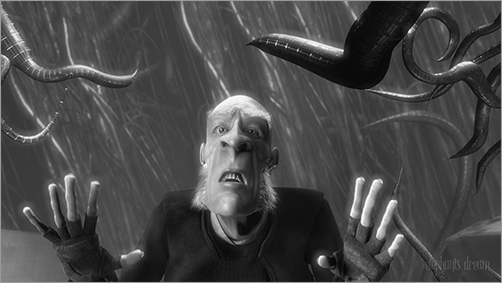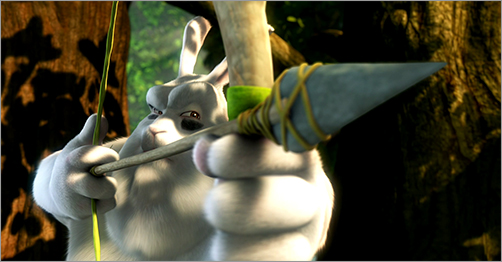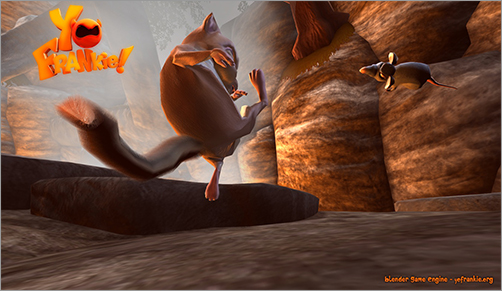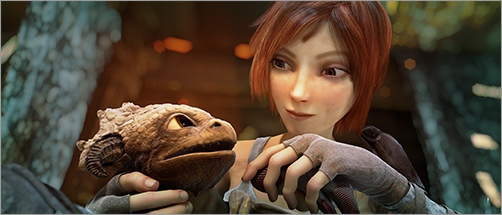Chapter 13
The Fruits of Freedom: Open Movies and Open Content
Software such as Blender cannot be developed in a vacuum. It is imperative that developers work hand in hand with highly skilled, dedicated artists to improve the software in the ways that really matter to creators. The developers of Blender, led by Ton Roosendaal, have taken this fact to heart. It was for this reason that the Blender Institute was established as an entity to put Blender to use in actual, fully realized productions. In the past five years, the Blender Open Movie Project has produced three stunning short movies, a game, and a growing series of training DVDs by some of the finest professional Blender users in the world, all released as open content under licenses that allow you to freely copy and reuse the material as you want. This chapter will introduce these projects and their backgrounds.
You’ll also take a brief look at some of the questions related to using free software in professional production. There are sometimes misunderstandings about the implications of using open source software on for-profit projects, and discussions about releasing content under a Creative Commons license can sometimes obscure the issue even further. This chapter ends by clarifying what these various licenses are and what they might mean to you and your project.
- The Blender Institute
- The Blender Open Movie Project
- Free and Open Licenses for Software and Content
). This movie was produced directly by the Blender Foundation, and its success was the motivating factor for establishing the Blender Institute. Elephants Dream was produced by Ton Roosendaal, founder of the Blender Foundation and chief developer of Blender. The film was directed by Bassam Kurdali.
Proog in Elephants Dream

The film was intended as a vehicle to demonstrate the potential of Blender in a large-scale production and also to spur the development of Blender in areas in which weaknesses became apparent. Production of the film was further constrained to using only open source software for all visual aspects of the film (the music was not subject to this constraint), which meant that functionality that could not be adequately found in other open source software, such as professional-quality video compositing, had to be built in to Blender.
The film itself is a dark and enigmatic piece of surrealist art. The story follows the journey of two strange men through the bowels of a bizarre and dangerous mechanical world, exploring the drastically (and eventually fatal) ways in which the two men perceive their surroundings. To be sure, the story is not everyone’s cup of tea. The creators of Elephants Dream took the freedom afforded by the software and the Creative Commons release very much to heart, eschewing any pretense of trying to make the film marketable or broadly accessible. Instead, they gave themselves complete creative freedom and created a short film that is both visually stunning and thematically provocative. In spite of the abstruseness of its subject matter, the film garnered a considerable amount of press attention for the way it was created and released, including a feature article in the Wall Street Journal.
As a demonstration of Blender’s capabilities, Elephants Dream holds up very well. Using advanced character modeling and animation tools and specially developed compositing functionality, Elephants Dream more than demonstrates that Blender is ready for prime time, visually speaking. Given the time and budgetary restrictions on the production and considering that many members of the team were relatively inexperienced in working in a production environment, the results are impressive. It’s also apparent from the freely available “making of” interviews that the team produced progressively better work as members became accustomed to working together.
The film is freely available in multiple formats—both as ordinary downloads and as BitTorrent files on the film’s official website (). You can also find the “making of” interviews and all the source .blend files at that website. You can also purchase the DVD, which has all these features as well as both NTSC and PAL versions of the film. The DVD that accompanies this book includes a high-resolution video of the film as well as all the source .blend files.
The Orange project also yielded a training video, Bassam Kurdali’s Mancandy FAQ, which gives a detailed overview of the rigging and animation techniques at the heart of Elephants Dream.
Big Buck Bunny
The second project was planned from the outset to be a bit sweeter and a lot furrier than Elephants Dream and so it received the project name Peach. The Peach team, headed by director Sacha Goedegebure, wanted to add a level of Disney-esque appeal not present in Elephants Dream and to take a more conventional approach to storytelling. These goals meshed perfectly with the development-related goal of putting the new hair particle functionality to rigorous use to make it more stable and usable. The Peach project resulted in the open movie Big Buck Bunny (see ), an irreverent send-up of all that is cute and furry.
In addition to advancements in particle hair, Big Buck Bunny took advantage of improvements in many other areas of Blender, notably in the armatures and rigging system.
Just as in the case of Elephants Dream, the movie was funded through a combination of outside grants and advance sales of the DVD. Also, like the previous movie, all digital assets, textures, and .blend files for Big Buck Bunny were released as open content along with the movie. DVD extras included tutorials and over-the-shoulder artist sessions.
The eponymous hero of Big Buck Bunny

Stills and clips from Big Buck Bunny made their way into a variety of unexpected places. As open content, it was ideal for use as sample video in showrooms or online. The Big Buck Bunny website is located at .
The Peach project also contributed to the Open Movie Workshop series of training videos with two-time open-movie veteran Andy Goralczyk’s Creature Factory training DVD on scene creation and animator William Reynish’s Learning Character Animation with Blender training DVD.
Yo Frankie!
Enthusiasm from Blender Game Engine users had built up to the point that it made sense for the next open project to be a game, rather than a movie. Assets and designs from Big Buck Bunny were used to get the project started on the right foot. The flying squirrel character from Big Buck Bunny was promoted to the leading role for Project Apricot, which ultimately resulted in the game Yo Frankie! (see ). As usual, the content was released as open content. You can find out more about Yo Frankie! at .
Project Apricot’s contribution to the Open Movie Workshop came in the form of Pablo Vasquez’s outstanding Venom’s Lab training video, which deals with a wide variety of techniques in modeling, texturing, lighting, and other areas.
Frankie the Flying Squirrel kicks a rat in Yo Frankie!

Sintel
The most recent open movie was the result of the long-awaited Durian project, carried out side by side with the development of the recoded Blender 2.5. The focus for Durian was on action, physics simulation, and engaging storytelling. For the first time, the team brought on an outside screenwriter to ensure that the story was as solid as it could be. The team adopted a more realistic style for this project than in the previous movies, inspired by such films as Final Fantasy: Advent’s Children. The Durian project was bigger in every respect than the previous projects; more people worked on the project and for a longer time. The result, the epic Sintel, directed by Colin Levy, did not disappoint. It is an action-packed short fantasy film about a young adventuress and the baby dragon she adopts (). It is making the rounds at film festivals at the time of this writing. Check out its website at .
Sintel was released as a four-DVD box set packed full of extras, including hours worth of in-depth tutorial videos from members of the creative team. In addition, concept artist David Revoy released the Chaos and Evolutions training DVD on creating 2D artwork with open source software as the latest installation of the Open Movie Workshop series.
Sintel and her baby dragon friend

Looking Forward to Mango and Gooseberry
As you read this, the Blender Institute is as active as ever preparing for the upcoming Project Mango, which will focus on integrating Blender-created CG content with live-action footage.
Beyond Mango lies Project Gooseberry, which is currently planned to be the Blender Institute’s first-ever feature-length movie. At the time of this writing, no further decisions about that project have been made public, but it will surely be an exciting step in the history of Blender and the Blender Open Movie Project.
Free and Open Licenses for Software and Content
Just as it’s worth understanding the similarities in spirit between open source software licenses and open content licenses, it’s also important to have a sense of how they differ. Open content is central to how the Blender Institute views its creative mission, but this is not necessarily the case for Blender-made projects. The fact that Blender is open source has no implications for the licensing of content made with Blender in general (I’m excluding the case of stand-alone games created with the Blender Game Engine because, to be honest, the back-and-forth on this topic makes my head spin, and at the time of this writing I’m not entirely clear on what the options are for games). In this section, I hope to give a brief overview of what some relevant licenses apply to and what their implications are.
Any discussion I attempt of licenses or copyright-related topics needs to be prefaced with the standard disclaimer: I am not a lawyer, and if you have any questions about how you should proceed with licensing or handling of copyrights, you should seek qualified legal advice. Anything I say on the subject is accurate to the best of my knowledge, but I might be insufficiently informed, out-of-date, or just plain wrong about details. I’ll include links to refer to the source documents where pertinent, but nevertheless, if you have legal questions, you should not rely on this book solely for your answers.
The license under which you release your work codifies the permissions that you are granting the public with regard to your work. Regardless of which license you choose to release the work under, you are the owner of the copyright for what you create. Individuals, companies, and organizations can feel fully at ease using open source software in their creative pipelines, knowing that their own rights with regard to their work will not be affected.
With that said, let’s take a look at these licenses.
GNU Public License
The GNU Public License (GPL) is one of the best known and most widely used licenses for what is referred to as free software or open source software. Blender’s code is released under the GPL. You can read the full text of the GPL at www.gnu.org/copyleft/gpl.html. The license was created by Richard Stallman, who is known for his advocacy of freely distributable, freely modifiable code. The GPL states, in essence, that the licensed code can be copied, modified, and redistributed by anybody without restriction, provided that modifications are clearly identified as such and that the subsequent derived code is also released under the GPL and according to the guidelines set out in the GPL.
The GPL is fairly strict in its insistence that free code interact primarily with other free code, although explicit exceptions are made for operating systems. Issues can arise with the use of nonopen libraries or APIs, so proprietary plug-ins for GPL software or GPL-derived plug-ins written for proprietary software can potentially infringe on the GPL. Other licenses exist, such as the Limited GPL and the Berkeley Software Distribution (BSD) license, which allow more freedom of interaction between free and proprietary code. You can learn more about the BSD license at http://en.wikipedia.org/wiki/BSD_license.
The writer of the code always retains the copyright to the code, and although that person can release non-GPL copies of their code at any time, any code already released under the GPL will remain so. Furthermore, with a code base as broad as Blender’s, there are numerous contributing coders and therefore many copyright holders, all of whom would have to agree to change the GPL status of future releases of their code if such a thing were to be considered (it isn’t).
The GPL deals with software. Specifically, it deals with publicly distributed software. You can do whatever you want with GPL code within the confines of your own project, and licensing of derived code need never become an issue until you decide to release your code to the world. In-house plug-ins or alterations are not a problem and do not need to follow any special criteria. Furthermore, the GPL bears no relation at all to content created with the software. Content you create with Blender or any other GPL software is copyrighted to you in the same way as content created in any other kind of software.
Creative Commons License
The Creative Commons license covers content and is an option for licensing your artistic creations. The decision to license your work under the Creative Commons license is entirely unrelated to the tools you used to create the work. Using open source software does not obligate you to release your work under a Creative Commons license.
There are several alternatives for Creative Commons licenses. You can license your work to be freely copied but require that the work be attributed to you and that copies of your work be restricted to noncommercial uses. You can allow commercial uses but require attribution, or you can relax the requirement for attribution.
If you want people to be able to freely copy, show, and distribute your work on the Web without fear of copyright repercussions, releasing your work under a noncommercial Creative Commons license might be a good choice. You remain the copyright holder, and you can revoke the license at any time. Your own use of the work (for example, if you sell it or license it for broadcast) might have an impact on whether you can continue to release it under the Creative Commons license if the buyer or broadcaster objects.
Blender Artistic License
The Blender Artistic license is a variation on the Creative Commons license and applies to images, .blend files, and animations. It allows copying and modification of files with some restrictions to ensure attribution. Material hosted on the www.blender.org website is required to be released under this license or the more permissive Open Content license. As in the case of the Creative Commons license, releasing work under this license is voluntary on the part of the creator and is not implied by using Blender to make the work.

